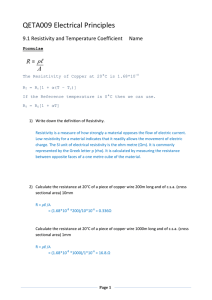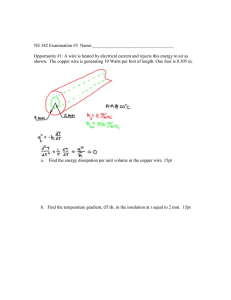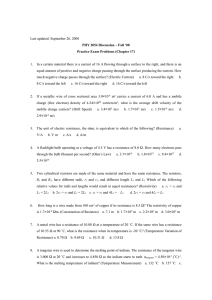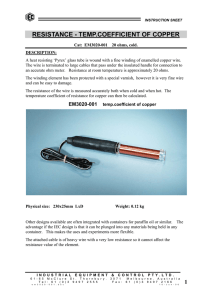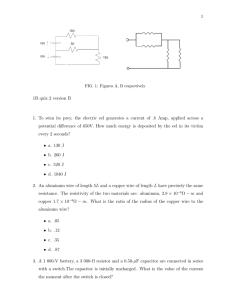QETA009 Electrical Principles
advertisement
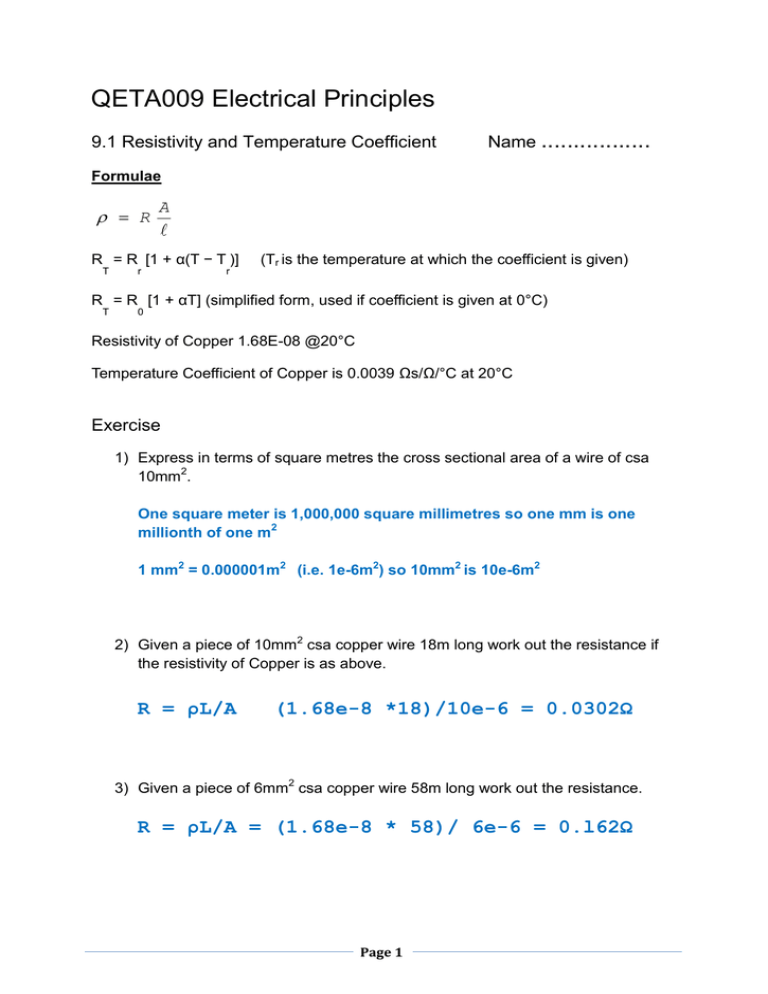
QETA009 Electrical Principles 9.1 Resistivity and Temperature Coefficient Name ................. Formulae R A R = R [1 + α(T − T )] T r r (Tr is the temperature at which the coefficient is given) R = R [1 + αT] (simplified form, used if coefficient is given at 0°C) T 0 Resistivity of Copper 1.68E-08 @20°C Temperature Coefficient of Copper is 0.0039 Ωs/Ω/°C at 20°C Exercise 1) Express in terms of square metres the cross sectional area of a wire of csa 10mm2. One square meter is 1,000,000 square millimetres so one mm is one millionth of one m2 1 mm2 = 0.000001m2 (i.e. 1e-6m2) so 10mm2 is 10e-6m2 2) Given a piece of 10mm2 csa copper wire 18m long work out the resistance if the resistivity of Copper is as above. R = ρL/A (1.68e-8 *18)/10e-6 = 0.0302Ω 3) Given a piece of 6mm2 csa copper wire 58m long work out the resistance. R = ρL/A = (1.68e-8 * 58)/ 6e-6 = 0.l62Ω Page 1 4) Work out the resistance of a piece of 1mm2 csa copper wire 200m long. R = ρL/A = (1.68e-8 * 200)/ 1e-6 = 3.36Ω 5) If a piece of copper wire has a resistance of 22Ω at 0°C what is its resistance at 120 degrees C? R = R [1 + α(T − T )] T r r R = 22[1 + 0.0039(120 − 0)] = 32.29Ω T If a piece of copper wire has a resistance of 22Ω at 20°C what is its resistance at 120 degrees C? R = R [1 + α(T − T )] T r r R = 22[1 + 0.0039(120 − 20)] = 22.39Ω T 6) If a piece of copper wire has a resistance of 11Ω at 0°C what is its resistance at 15°C? R = R [1 + α(T − T )] T r r R = 11[1 + 0.0039(15 − 0)] = 11.643 Ω T 7) If we have a piece of wire 100m long and a csa of 10mm 2 what is the resistivity of the material if the resistance of the sample is 0.85Ω? ρ = RA/L =(0.85*10e-6)/100 = 8.5e-8 Page 2 8) If a piece of copper has a resistance of 0.55Ω at 20°C what is its resistance at 100 degrees C? R = R [1 + α(T − T )] T r r R = 0.55[1 + 0.0039(100− 20)] = 0.862Ω T 9) Express in terms of square metres the cross sectional area of a wire of csa 15mm2. 15e-6m2 10) Explain the term Negative temperature Coefficient with respect to resistors. If a resistance has a negative temperature coefficient then its resistance decreases with increasing temperature. 11) Resistance Ω 110.00 108.00 106.00 104.00 102.00 100.00 98.00 96.00 20 21 22 23 24 25 26 27 28 29 30 31 32 33 34 35 36 37 38 Temp °C In the chart above, state if this line demonstrates Positive or Negative Temperature Coefficient and, from the line, work out the value of the Temperature Coefficient for the resistor that this chart represents. This is chart for a PTC and its temperature coefficient is 6/15 = 0.4 Page 3 12) Describe, using diagrams, how you would determine a rough value for the Temperature Coefficient of a resistor. Draw a sketch of the equipment that you would assemble to do this and write the method for the experiment below. Page 4 13) Look at the table below and decide if the two components shown are NTC or PTC 14) Using the figures from the table above roughly estimate the value of resistance for the 100Ω Thermistor when the temperature is 50°C 15) State why this kind of estimation is less reliable for a NTC Thermistor The curve for an NTC component is not linear so estimations made without the curve are invalid. Page 5
